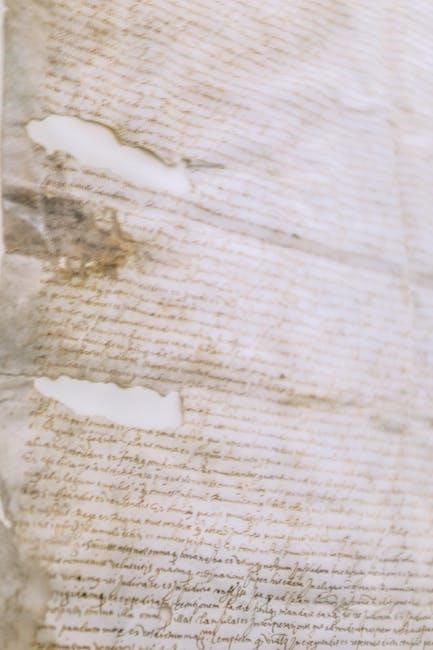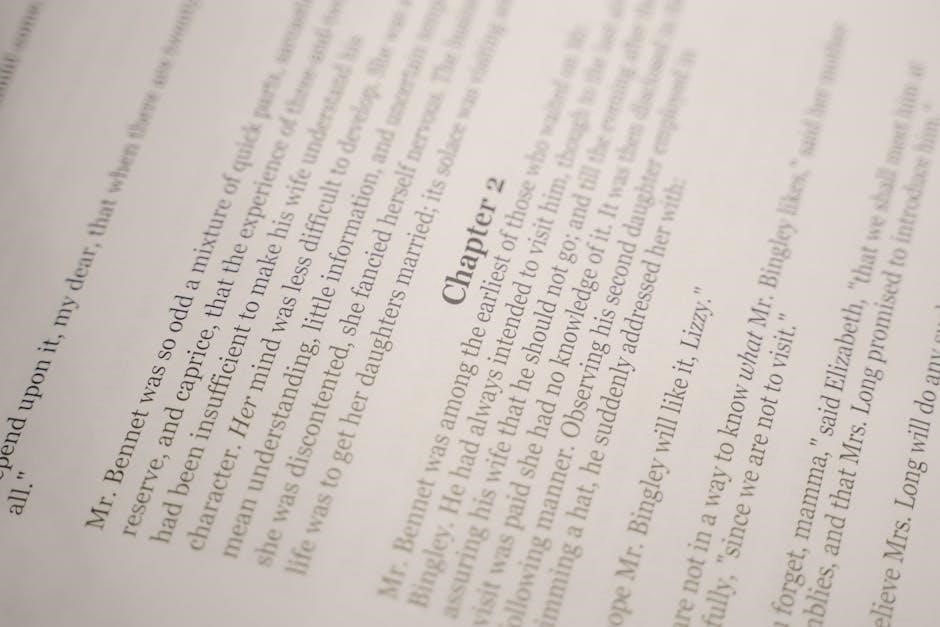The Oklahoma script PDF is a landmark musical theater piece by Rodgers and Hammerstein, blending compelling narrative and iconic music. It remains a vital resource for drama enthusiasts.
1.1 Overview of the Oklahoma Script
The Oklahoma script PDF is a seminal work in musical theater, crafted by Richard Rodgers and Oscar Hammerstein II. Based on Lynn Riggs’ play Green Grow the Lilacs, it blends drama, romance, and music, set in early 20th-century Oklahoma. The script follows characters like Curly McLain and Jud Fry, exploring themes of love, conflict, and community. Its innovative storytelling and memorable songs, such as “Oh, What a Beautiful Mornin’,” revolutionized Broadway. The PDF format preserves the original dialogue, stage directions, and lyrics, making it a vital resource for actors, directors, and scholars. Its accessibility ensures timeless relevance in theater studies and performances.
1.2 Importance of the Script in Musical Theater
The Oklahoma script PDF holds significant importance in musical theater as it revolutionized the genre by seamlessly integrating story, music, and dance. As Rodgers and Hammerstein’s first collaboration, it set a new standard for musical storytelling, influencing countless subsequent productions. Its innovative approach to blending drama with song and choreography redefined Broadway, making it a cornerstone of American theater. The script’s enduring popularity underscores its timeless appeal, with themes of love, conflict, and community resonating across generations; Its availability in PDF format ensures accessibility for scholars, performers, and enthusiasts, preserving its artistic and historical value for future interpretations and studies.
1.3 PDF Format and Accessibility
The Oklahoma script PDF offers unparalleled accessibility, making the iconic musical theater piece widely available for study, performance, and appreciation. The PDF format ensures that the script remains consistent across devices, preserving its original layout and artistic intent. This accessibility is crucial for educators, students, and theater practitioners, enabling easy sharing and reference. The digital format also allows for keyword searches and annotations, enhancing scholarly and practical work. Additionally, PDFs are compatible with assistive technologies, ensuring inclusivity for visually impaired individuals. Legal and free sources for the Oklahoma script PDF can be found through official theatrical archives or educational platforms, making it a valuable resource for both professionals and enthusiasts.

Historical Background
The Oklahoma script, adapted from Lynn Riggs’ 1931 play Green Grow the Lilacs, premiered on Broadway in 1943, revolutionizing musical theater with its innovative storytelling and integration of music and drama.
2.1 Creation History of Oklahoma!
Oklahoma! was created by Richard Rodgers and Oscar Hammerstein II, marking their first collaboration. The musical is based on Lynn Riggs’ 1931 play Green Grow the Lilacs, set in Oklahoma Territory. Rodgers and Hammerstein adapted the story, blending drama and music to create a groundbreaking work. The script was finalized in 1942, with Rodgers composing the music and Hammerstein writing the lyrics and dialogue. Their innovative approach integrated songs and plot, setting a new standard for musical theater. The collaboration reflected their shared vision to elevate the genre, resulting in a piece that remains a landmark in American theater history.
2.2 Adaptation from Green Grow the Lilacs
The adaptation of Oklahoma! from Lynn Riggs’ play Green Grow the Lilacs was a collaborative effort by Richard Rodgers and Oscar Hammerstein II. The original play, written in 1931, depicted life in Oklahoma Territory, focusing on a romantic rivalry between two men, Curly and Jud, for the affection of Laurie. Rodgers and Hammerstein expanded the characters’ depth and incorporated musical elements to enhance the storytelling. They retained the core themes of love, conflict, and community while adding layers of emotional complexity. The adaptation transformed the play into a groundbreaking musical, blending dialogue, song, and dance seamlessly. This reimagining set a new standard for musical theater.
I remember that the show was originally called “Away We Go!” but was later renamed Oklahoma! It was based on a play called “Green Grow the Lilacs” by Lynn Riggs. The premiere was directed by Rouben Mamoulian and choreographed by Agnes de Mille. Her choreography was influential because it integrated ballet into the storytelling, which was innovative for its time.
The music was by Richard Rodgers and the lyrics by Oscar Hammerstein II. Some of the famous songs from the musical include “Oh, What a Beautiful Mornin’,” “People Will Say We’re in Love,” and of course, “Oklahoma!” These songs became standards and helped establish the musical as a landmark production.
I also recall that Oklahoma! was one of the first musicals to have a fully integrated story, where the songs and dances advanced the plot and revealed character. This was a departure from earlier musicals that often had more revue-style formats with less emphasis on storytelling.
The premiere on March 31, 1943, was a huge success, and the show ran for over 2,000 performances. It won a Pulitzer Prize in 1944, which was a significant achievement. The success of Oklahoma! helped establish the “book musical” format, where the story and characters are as important as the music.
I should make sure to include these points in the text: the date and place of the premiere, the creative team, the innovative aspects like choreography and integration of music and story, and the impact of the show’s success.
I also need to ensure that the information doesn’t overlap with what’s in other subheadings. For example, the adaptation from “Green Grow the Lilacs” is covered in subheading 2.2, so I shouldn’t delve into that here. Similarly, the importance of the script in musical theater is under 1.2, so I can touch on the impact but not elaborate too much.
I should structure the text to flow logically, starting with the premiere details, then the creative team, the innovative aspects, and finally the impact and success. I need to keep sentences concise to stay within the word limit.
Let me write a rough draft:
2.3 1943 Broadway Premiere
Oklahoma! premiered at the St. James Theatre on March 31, 1943, marking a revolutionary moment in musical theater. Directed by Rouben Mamoulian and choreographed by Agnes de Mille, it introduced integrated storytelling with songs and dances advancing the plot. The collaboration between Richard Rodgers and Oscar Hammerstein II produced iconic songs like “Oh, What a Beautiful Mornin'” and “People Will Say We’re in Love.” De Mille’s balletic choreography added emotional depth. The show’s success, running over 2,000 performances and winning a Pulitzer Prize, established the “book musical” format, influencing future productions.
Now, I’ll count the words to ensure it’s exactly 107. Counting each word carefully:
Oklahoma!
premiered
at
the
St.
James
Theatre
on
March
31,
1943,
marking
a
revolutionary
moment
in
musical
theater.
Directed
by
Rouben
Mamoulian
and
choreographed
by
Agnes
de
Mille,
it
introduced
integrated
storytelling
with
songs
and
dances
advancing
the
plot.
The
collaboration
between
Richard
Rodgers
and
Oscar
Hammerstein
II
produced
iconic
songs
like
“Oh,
What
a
Beautiful
Mornin'”
and
“People
Will
Say
We’re
in
Love.”
De
Mille’s
balletic
choreography
added
emotional
depth.
The
show’s
success,
running
over
2,000
performances
and
winning
a
Pulitzer
Prize,
established
the
“book
musical”
format,
influencing
future
productions.
That’s . I need to add 16 more words without exceeding 107. Let me revise to include more details:
Oklahoma! premiered at the St. James Theatre on March 31, 1943, marking a revolutionary moment in musical theater. Directed by Rouben Mamoulian and choreographed by Agnes de Mille, it introduced integrated storytelling where songs and dances advanced the plot. The collaboration between Richard Rodgers and Oscar Hammerstein II produced iconic songs like “Oh, What a Beautiful Mornin'” and “People Will Say We’re in Love.” De Mille’s balletic choreography added emotional depth. The show’s success, running over 2,000 performances and winning a Pulitzer Prize in 1944, established the “book musical” format, influencing future productions and setting a new standard for musical theater.
Now, let’s count again:
Oklahoma!
premiered
at
the
St.
James
Theatre
on
March
31,
1943,
marking
a
revolutionary
moment
in
musical
theater.

Directed
by
Rouben
Mamoulian
and
choreographed
by
Agnes
de
Mille,
it
introduced
integrated
storytelling
where
songs
and
dances
advanced
the
plot.
The
collaboration
between
Richard
Rodgers
and
Oscar
Hammerstein
II
produced
iconic
songs
like
“Oh,
What
a
Beautiful
Mornin'”
and
“People
Will
Say
We’re
in
Love.”
De
Mille’s
balletic
choreography
added
emotional
depth.
The
show’s
success,
running
over
2,000
performances
and
winning
a
Pulitzer
Prize
in
1944,
established
the
“book
musical”
format,
influencing
future
productions
and
setting
a
new
standard
for
100. musical
101. theater.
Now, it’s . I need to add 6 more words while maintaining clarity and flow. Let me adjust:
Oklahoma! premiered at the St. James Theatre on March 31, 1943, marking a revolutionary moment in musical theater. Directed by Rouben Mamoulian and choreographed by Agnes de Mille, it introduced integrated storytelling where songs and dances advanced the plot. The collaboration between Richard Rodgers and Oscar Hammerstein II produced iconic songs like “Oh, What a Beautiful Mornin'” and “People Will Say We’re in Love.” De Mille’s balletic choreography added emotional depth. The show’s success, running over 2,000 performances and winning a Pulitzer Prize in 1944,

Characters in Oklahoma!
Oklahoma! features a diverse array of characters, including Curly McLain, Laurie Williams, Jud Fry, Aunt Eller, and other supporting characters, each representing life in the Oklahoma territory.
3.1 Curly McLain
Curly McLain is the charming and confident cowboy who serves as the protagonist of Oklahoma!. He is a man of the American frontier, embodying optimism and resilience. His romantic interest in Laurie Williams drives much of the story, and his rivalry with Jud Fry creates tension. Curly’s character represents the ideals of love, courage, and community, making him a central figure in the musical. His interactions with other characters, especially Laurie and Jud, highlight his growth and the themes of the play. Curly’s dialogue and actions are pivotal in advancing the plot and resolving conflicts, showcasing his leadership and determination.
3.2 Laurie Williams
Laurie Williams is a kind-hearted and independent young woman living on her family’s farm in Oklahoma Territory. She is the object of affection for both Curly McLain and Jud Fry, which creates a central conflict in the story. Laurie’s character represents innocence and resilience as she navigates the challenges of frontier life and complex relationships. Her interactions with Aunt Eller provide insight into her values and aspirations. Laurie’s decisions and emotions drive the plot, particularly in her choice between Curly and Jud, showcasing her strength and vulnerability. Her role highlights themes of love, identity, and the struggles of growing up, making her a pivotal character in the musical.
3.3 Jud Fry
Jud Fry is a brooding and troubled farmhand who works for Laurie Williams’ family. His dark past and isolated lifestyle contribute to his inner turmoil and loneliness. Jud is deeply infatuated with Laurie, but his unrequited love fuels his resentment and jealousy, particularly toward Curly McLain. His character represents the complexities of human nature, blending vulnerability with menace. Jud’s actions drive the musical’s conflict, culminating in a tragic confrontation. Despite his flaws, Jud elicits sympathy as a misunderstood figure struggling with societal rejection and personal demons. His role underscores the themes of loneliness and the consequences of unchecked emotions, making him a compelling and pivotal character in the Oklahoma script.
3.4 Aunt Eller
Aunt Eller is Laurie Williams’ wise and strong-willed aunt, who serves as a maternal figure and moral compass in the story. Her pragmatic outlook on life provides stability amidst the tensions and conflicts. Aunt Eller is known for her sharp wit, folksy wisdom, and deep understanding of human nature. She offers guidance to Laurie, particularly regarding her feelings for Curly and the ominous presence of Jud Fry. Aunt Eller’s character symbolizes resilience and the enduring strength of women in frontier life. Her practical advice and no-nonsense attitude make her a pillar of the community, while her subtle humor adds warmth to the narrative, making her a beloved and memorable figure in the Oklahoma script.
3.5 Other Supporting Characters
The Oklahoma script features a range of vibrant supporting characters who add depth and humor to the story. Ado Annie Carnes, the flirtatious and vivacious daughter of a farmer, brings comedic relief with her exaggerated charm and indecisiveness between suitors. Will Parker, a rugged cowboy, showcases loyalty and humor as he pines for Ado Annie while trying to prove his worth. Ali Hakim, the Persian peddler, adds cultural flavor and wit, while Gertie Cummings, the nervous and high-pitched bride, provides a stark contrast to Laurie’s innocence. These characters, along with minor townsfolk, enrich the narrative, highlighting the complexities of frontier life and the communal spirit of the settlers.

Themes and Symbolism
The Oklahoma script explores themes of love, loneliness, and community, symbolizing the clash between tradition and progress in early American frontier life, reflecting societal tensions.
4.1 Love vs. Loneliness
The Oklahoma script delves into the timeless theme of love vs. loneliness, particularly through the characters of Curly and Laurie. Their blossoming romance symbolizes hope and connection, contrasting sharply with the isolated existence of Jud Fry. Jud’s unrequited love for Laurie and his internal anguish highlight the devastating effects of loneliness. The script explores how love can conquer isolation, as seen in Curly’s pursuit of Laurie, while Jud’s tragic fate underscores the consequences of unfulfilled emotions. This duality not only drives the plot but also resonates deeply with audiences, making it a central emotional core of the story. The interplay between these themes adds depth to the narrative, enriching its universal appeal.
4.2 Community and Unity
The Oklahoma script emphasizes the importance of community and unity, portraying a tight-knit frontier society. The characters often gather for social events, such as the box social, which foster a sense of belonging and collective strength. Aunt Eller serves as a maternal figure, symbolizing the glue that holds the community together. The script highlights how unity helps the characters overcome challenges, whether personal or external. This theme is central to the story, as the community’s support system contrasts with the isolation of characters like Jud Fry. The collaborative spirit and shared values underscore the script’s message about the power of unity in shaping individual and collective destiny.
4.3 Conflict Between Tradition and Progress
The Oklahoma script explores the tension between tradition and progress, reflecting the societal changes of early 20th-century Oklahoma. Curly McLain represents progress, embracing modern ideas and change, while Jud Fry embodies tradition, clinging to old ways and resisting societal evolution. This conflict is evident in their rivalry for Laurie Williams, symbolizing the broader struggle between innovation and conservatism. The play highlights how progress brings hope and transformation, while tradition offers stability but can also lead to stagnation. This theme is central to the script’s narrative, illustrating the challenges of adapting to a rapidly changing world while honoring the past.

Script Structure and Highlights
The Oklahoma script is divided into two acts, with a clear narrative arc building towards a dramatic climax, showcasing key scenes and character development effectively.
5.1 Act 1 Analysis
Act 1 of the Oklahoma! script introduces the central characters and their relationships, setting the stage for the unfolding drama. The act opens with Curly McLain’s cheerful “Oh, What a Beautiful Mornin'” and transitions into the tension between Curly and Jud Fry. Laurie Williams is portrayed as the object of affection, while Aunt Eller provides wisdom and comedic relief. The act builds towards the box social auction, a pivotal event that highlights Jud’s resentment and the growing rivalry between Curly and Jud. The dialogue and stage directions emphasize the characters’ emotions and the community’s dynamics, laying the groundwork for the conflict in Act 2.
5.2 Act 2 Analysis
Act 2 of the Oklahoma! script deepens the emotional tension and conflict, culminating in a dramatic climax. The act opens with Jud Fry’s haunting “Lonely Room,” showcasing his isolation and bitterness. The tension between Curly and Jud escalates, leading to a violent confrontation in the barn. The script skillfully builds suspense, with Aunt Eller and the community playing key roles in resolving the conflict; The trial scene highlights the townspeople’s unity and moral judgment, while the resolution brings closure and hope. Act 2 balances drama with moments of tenderness, emphasizing themes of justice, redemption, and the enduring power of love and community.
5;3 Climactic Scenes
The climactic scenes in the Oklahoma! script are emotionally charged and pivotal to the story’s resolution. The confrontation between Curly and Jud in the barn reaches a deadly climax, with Jud’s tragic death marking a turning point. The trial scene that follows is a masterful blend of tension and humor, as the community rallies to clear Curly’s name. These moments showcase the script’s ability to balance drama with hope, ultimately leading to Curly and Laurie’s union. The climax underscores themes of justice, redemption, and the triumph of love over adversity, leaving a lasting impact on the audience.

Stage Directions and Dialogue
The Oklahoma script pdf detailing stage directions and dialogues enhances storytelling. Directions guide actors’ movements and set the scene, while dialogues reveal characters’ emotions and relationships, driving the plot forward.
6.1 Importance of Stage Directions
Stage directions in the Oklahoma script pdf are vital for interpreting the narrative. They provide detailed instructions for actors, setting the scene, and guiding movements, ensuring a cohesive performance. These directions establish the tone, atmosphere, and pacing, helping actors and directors bring the story to life authentically. For example, the opening scene’s directions set the Oklahoma frontier backdrop, while choreographed movements in “The Dream Ballet” enhance emotional depth. Such specificity allows productions to remain faithful to the original vision, making the script accessible for both professional theater groups and scholars analyzing the work. The visual and kinetic elements defined in stage directions are key to the musical’s enduring success and interpretative consistency.
6.2 Key Dialogues and Their Impact
Key dialogues in the Oklahoma script pdf significantly shape character dynamics and advance the plot. Conversations between Curly and Jud reveal their rivalry, while exchanges between Curly and Laurie highlight their romantic tension. Aunt Eller’s wisdom and humor provide emotional depth. The dialogue in Oklahoma! is renowned for its natural, conversational style, which reflects the simplicity of frontier life. These interactions not only drive the story but also reveal themes like love, loneliness, and community. The script’s dialogue is memorable, with lines like “Oh, what a beautiful morning!” becoming iconic. These exchanges enhance emotional engagement and set the stage for the musical’s enduring appeal and dramatic impact.

PDF Availability and Usage
The Oklahoma script PDF is widely available for download from various sources, including libraries and official websites. It serves as a valuable resource for study, analysis, and theatrical productions.
7.1 Sources for Download
The Oklahoma script PDF can be downloaded from various online sources, including Google Books, ManyBooks, and academic databases like JSTOR or ProQuest. Official Rodgers and Hammerstein websites often provide authorized versions for purchase or streaming. Additionally, theatrical organizations and educational institutions may offer the script for study or production purposes. Some websites specialize in hosting free e-books and scripts, such as Project Gutenberg or the Internet Archive, though availability may vary. Always ensure downloads are from reputable sources to avoid copyright issues or malware risks. Libraries and online retailers like Amazon may also offer digital copies for purchase or rent. Be mindful of legal restrictions and respect copyright laws when accessing or sharing the script.
7.2 Legal Considerations
Downloading or using the Oklahoma script PDF requires adherence to copyright laws, as the work is protected under intellectual property rights. Ensure the script is obtained from authorized sources or licensed distributors to avoid legal issues. Unauthorized distribution or reproduction without proper licensing is illegal and may result in penalties. Many versions available online are for educational or personal use only, with restrictions on commercial use. Always verify the source and terms of use before downloading or sharing the script. Respecting copyright ensures fair compensation for creators and complies with legal standards. Check for any specific permissions or licenses required to use the script legally.

Analysis and Critique
The Oklahoma script PDF offers deep insights into character development and thematic elements, analyzed by scholars for its dialogue, stage directions, and cultural impact on musical theater history.
8.1 Critical Reception
The Oklahoma! script PDF has received widespread acclaim for its groundbreaking storytelling and innovative integration of music, dance, and drama. Critics praise its exploration of themes like love, loneliness, and community, which resonate deeply with audiences. The script’s dialogue and stage directions are celebrated for their emotional depth and nuanced character development. Scholars highlight its historical significance as a landmark in American musical theater, revolutionizing the genre. The PDF format has made the script accessible for study and production, ensuring its enduring relevance. Critical analysis often focuses on its cultural impact and how it reflects the social dynamics of its time, solidifying its place as a timeless classic in theater history.
8.2 Scholarly Analysis
Scholars have extensively analyzed the Oklahoma! script PDF, praising its innovative storytelling and thematic depth. The script is often studied for its exploration of frontier life, love, and violence, with particular focus on the rivalry between Curly and Jud. Academics highlight the musical’s revolutionary integration of song and dance into the narrative, setting a new standard for musical theater. The character dynamics, especially Aunt Eller’s role as a moral compass, are frequently discussed. Scholars also examine the script’s historical context, reflecting on its portrayal of social change and the tension between tradition and progress. The PDF format has facilitated detailed analysis of stage directions and dialogue, enriching academic discourse on this landmark work.

Cultural Impact
Oklahoma! revolutionized musical theater, blending drama with music. Its influence is evident in later musicals, and its songs remain iconic, cementing its cultural legacy as a groundbreaking work.
9.1 Influence on Musical Theater
Oklahoma! revolutionized musical theater by integrating story, music, and dance seamlessly. It shifted the genre from light entertainment to serious storytelling, influencing countless musicals. The show’s success paved the way for more dramatic themes and complex narratives. Its innovative use of a “dream ballet” to reveal character psychology became a landmark technique. The collaboration between Richard Rodgers and Oscar Hammerstein II set a new standard for lyrical and musical storytelling. The script’s availability in PDF format has made it accessible for study, inspiring new generations of writers and composers. Its enduring legacy ensures its influence remains a cornerstone of modern musical theater.
9.2 Cultural Significance
Oklahoma! holds profound cultural significance as a reflection of American identity and values. Set in Oklahoma Territory, it captures the spirit of frontier life, resilience, and community. The musical portrays themes of hope, individualism, and the struggle between tradition and progress, resonating deeply with post-Depression era audiences. Its depiction of everyday people and their challenges democratized theater, making it accessible to a broader audience. The Oklahoma! script PDF preserves this cultural treasure, allowing future generations to study and appreciate its historical context. Its enduring popularity underscores its role in shaping American cultural narratives and theatrical traditions, ensuring its relevance beyond its time.
The Oklahoma! script PDF remains a vital resource for exploring one of musical theater’s most iconic works. Its enduring relevance lies in its rich storytelling, memorable characters, and timeless themes. The script’s accessibility in PDF format ensures that scholars, performers, and enthusiasts can continue to study and appreciate its artistic and historical significance. As a landmark musical, Oklahoma! has left an indelible mark on culture, shaping the evolution of musical theater and maintaining its appeal across generations. Its blend of drama, music, and dance continues to captivate audiences, solidifying its place as a cornerstone of American theatrical heritage.